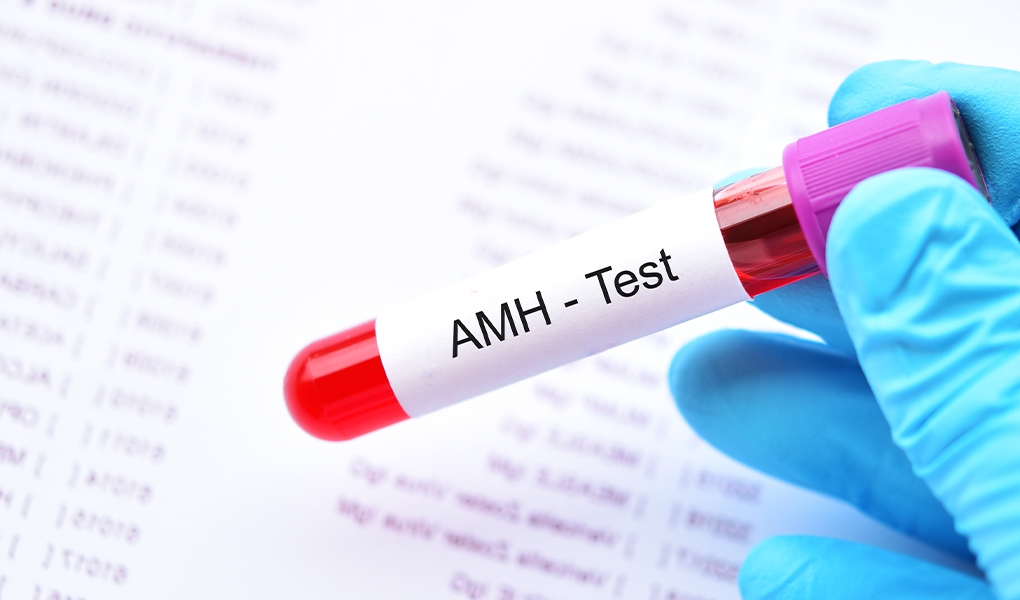Follow Us!
Patient stories, informative videos and much more on our social media accounts

The Anti-Müllerian Hormone (AMH) test is one of the most important laboratory tests used today to evaluate female fertility and ovarian reserve. AMH provides valuable information about a woman’s reproductive potential and plays a key role in fertility planning, IVF treatment decisions, and the assessment of conditions such as early menopause or polycystic ovary syndrome (PCOS).
Unlike many other reproductive hormones, AMH levels remain relatively stable throughout the menstrual cycle, making it a reliable marker for assessing ovarian function at almost any time.
Anti-Müllerian Hormone is a glycoprotein hormone produced in both males and females, but its function differs by sex.
In women, AMH reflects the number of small, developing follicles in the ovaries. For this reason, AMH is considered a direct indicator of ovarian reserve, which represents the remaining quantity of eggs.
AMH secretion begins late in fetal life, continues throughout the reproductive years, and gradually declines until it becomes undetectable after menopause.
The AMH test is a blood test that measures the level of Anti-Müllerian Hormone in the bloodstream. Because women are born with a finite number of eggs, ovarian reserve naturally decreases with age. AMH helps estimate how many eggs remain.
For this reason, the AMH test is commonly referred to as an “egg reserve test.”
Unlike hormones such as FSH or estrogen:
The AMH test is performed for several important clinical reasons:
Because AMH is secreted directly by ovarian follicles, it is often preferred over FSH in modern fertility evaluations.
The AMH test is a simple blood test performed in a laboratory setting.
Although the test procedure itself is straightforward, interpretation requires clinical expertise, as AMH values must be evaluated together with age, ultrasound findings, and overall reproductive history.
AMH values are measured in ng/mL and should always be interpreted based on age.
AMH naturally declines with age, even in healthy women. A “normal” AMH level for a 25-year-old may be considered low for a younger woman but expected for someone in their late 30s.
Low AMH indicates a reduced ovarian reserve. This does not mean pregnancy is impossible, but it may suggest:
Low AMH is often associated with:
It is important to note that AMH does not measure egg quality, only quantity. Pregnancy can still occur naturally or with assisted reproductive techniques.
Currently, there is no proven medication or supplement that can increase AMH levels.
Lifestyle changes may support overall reproductive health, but they do not restore ovarian reserve. For women with low AMH who wish to conceive, early consultation with a fertility specialist is strongly recommended.
High AMH levels are commonly seen in women with Polycystic Ovary Syndrome (PCOS).
In PCOS:
High AMH in PCOS does not always indicate better fertility and may be associated with an increased risk of ovarian hyperstimulation syndrome (OHSS) during IVF.
AMH is a critical parameter in IVF planning because it helps predict:
Women with very low AMH may still achieve pregnancy with IVF, but protocols must be carefully tailored. In some cases, egg freezing or alternative reproductive options may be discussed.
AMH provides information about ovarian reserve but cannot predict the exact timing of menopause.
A low AMH suggests declining awareness, but menopause depends on multiple factors, including genetics and overall ovarian function.
Normal AMH levels typically range between 1.5 and 4.0 ng/mL, depending on age.
Yes. Low AMH does not mean infertility, but fertility planning should not be delayed.
No. AMH remains relatively stable and can be tested on any day.
In most cases, hormonal contraceptives have minimal effect on AMH levels.
Not necessarily. High AMH may indicate PCOS and requires proper medical evaluation.
The AMH test is one of the most valuable tools in modern reproductive medicine. It provides essential insight into ovarian reserve, fertility potential, and treatment planning. While AMH does not determine pregnancy on its own, it plays a crucial role in guiding informed and timely reproductive decisions.
If you are considering fertility treatment, egg freezing, or simply want to understand your reproductive health better, consulting a specialist and interpreting AMH results correctly is key.
For further information or consultation, you may contact us at 444 39 49.
Let us call you as soon as possible regarding the issues you want to consult.


